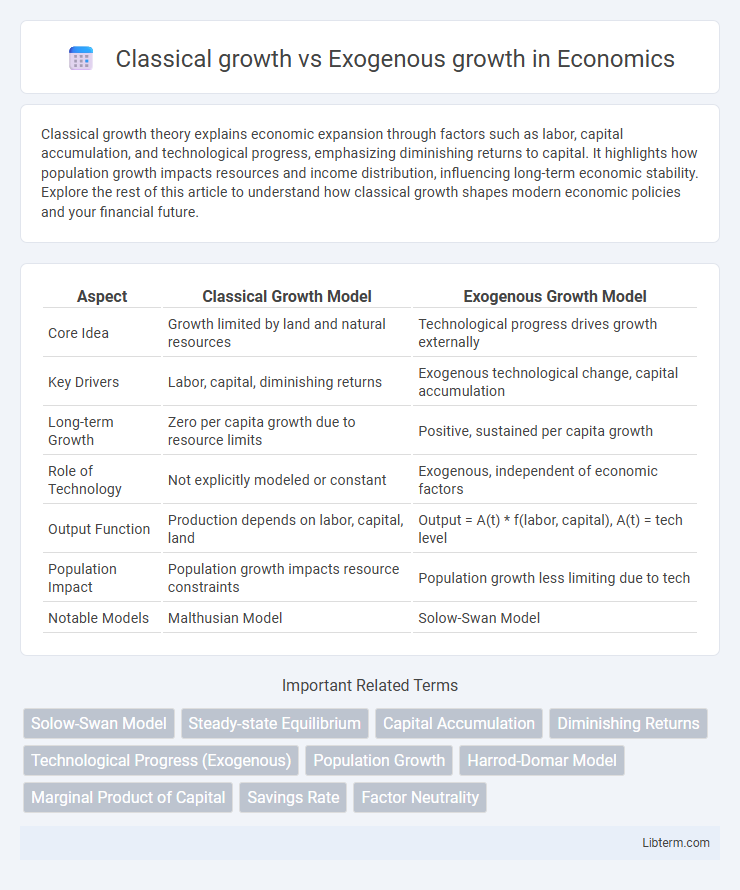Classical growth theory explains economic expansion through factors such as labor, capital accumulation, and technological progress, emphasizing diminishing returns to capital. It highlights how population growth impacts resources and income distribution, influencing long-term economic stability. Explore the rest of this article to understand how classical growth shapes modern economic policies and your financial future.
Table of Comparison
| Aspect | Classical Growth Model | Exogenous Growth Model |
|---|---|---|
| Core Idea | Growth limited by land and natural resources | Technological progress drives growth externally |
| Key Drivers | Labor, capital, diminishing returns | Exogenous technological change, capital accumulation |
| Long-term Growth | Zero per capita growth due to resource limits | Positive, sustained per capita growth |
| Role of Technology | Not explicitly modeled or constant | Exogenous, independent of economic factors |
| Output Function | Production depends on labor, capital, land | Output = A(t) * f(labor, capital), A(t) = tech level |
| Population Impact | Population growth impacts resource constraints | Population growth less limiting due to tech |
| Notable Models | Malthusian Model | Solow-Swan Model |
Understanding Classical Growth Theory
Classical growth theory emphasizes population growth as the main driver of economic expansion, where increased labor leads to diminishing returns and eventual stagnation without technological progress. It contrasts with exogenous growth models by attributing long-run growth limits to fixed resources and declining marginal productivity. Understanding classical growth theory highlights the role of natural constraints and the necessity of technological innovation to sustain economic growth beyond subsistence levels.
Key Principles of Exogenous Growth Theory
Exogenous growth theory emphasizes that long-term economic growth is driven by external factors, primarily technological progress, which is considered independent of the economy's internal dynamics. The Solow-Swan model, a foundational framework of this theory, highlights capital accumulation, labor growth, and exogenous technological advancement as key drivers, assuming technological improvements occur at a constant, outside rate. This approach contrasts with classical growth models by treating technology as an unexplained variable that fundamentally shapes productivity and output growth over time.
Historical Contexts: Classical vs Exogenous Models
Classical growth models, rooted in the 18th and 19th centuries, emphasize diminishing returns to capital and the role of land scarcity in limiting economic expansion, reflecting the agricultural economies of that era. Exogenous growth models, developed in the 20th century, incorporate technological progress as an external factor driving sustained long-term growth, departing from Classical constraints. These differing assumptions highlight the historical transition from resource-based growth limitations to technology-driven economic development.
Assumptions Underlying Classical Growth
Classical growth theory assumes diminishing returns to capital and land, implying that economic growth slows as resources become scarce. It posits that population growth is driven by income levels, which in turn affects output per capita. The model emphasizes that technological progress is exogenous and not a direct factor influencing long-term growth within the classical framework.
Drivers of Growth in Exogenous Models
Exogenous growth models, such as the Solow-Swan model, attribute economic growth primarily to external factors like technological progress, which is considered an independent and unexplained driver. Capital accumulation and labor force expansion are inputs but exhibit diminishing returns, making technological innovation the key to sustained long-term growth. These models emphasize that policy changes or investment can only influence growth temporarily until the economy reaches a new steady state dictated by exogenous technological improvements.
Role of Technology in Economic Expansion
Classical growth theory attributes economic expansion primarily to increasing inputs like labor and capital, with technological progress viewed as an external factor that does not fundamentally alter long-term growth rates. Exogenous growth theory, especially the Solow model, treats technology as an external, unexplained driver that enhances productivity and sustains growth beyond input accumulation. The role of technology in exogenous growth frameworks is crucial for raising total factor productivity, making it a key determinant of economic expansion that classical models do not endogenize.
Policy Implications: Classical Versus Exogenous Approaches
Classical growth models emphasize the role of diminishing returns to capital and labor, suggesting that policy should focus on increasing savings and improving factor productivity to sustain growth. Exogenous growth theory highlights technological progress as an external factor, implying that policies promoting innovation, research and development, and human capital investment are crucial for long-term economic expansion. Effective economic policy must therefore balance resource allocation between immediate factor accumulation and fostering technological advancement to achieve sustainable growth.
Capital Accumulation and Productivity Differences
Classical growth theory emphasizes capital accumulation as the primary driver of economic expansion, where increases in physical capital lead to higher output until diminishing returns set in. Exogenous growth models incorporate technological progress as an external factor, allowing sustained productivity improvements independent of capital accumulation. The key difference lies in productivity dynamics: classical growth faces productivity stagnation due to fixed technology, whereas exogenous growth attributes long-term growth to continuous technological innovation enhancing total factor productivity.
Criticisms and Limitations of Each Theory
Classical growth theory faces criticism for its assumption of diminishing returns to capital, which limits long-term growth predictions and overlooks technological progress as an endogenous factor. Exogenous growth theory, while incorporating technological change as an external factor, is criticized for not explaining the sources of innovation and human capital development internally within the model. Both theories struggle to fully address the complexities of growth dynamics, including institutional influences and knowledge spillovers, which are essential for sustained economic expansion.
Future Perspectives on Economic Growth Models
Classical growth models emphasize diminishing returns to capital and labor as constraints on long-term economic expansion, suggesting that population growth limits per capita income. In contrast, exogenous growth models, such as the Solow-Swan framework, incorporate technological progress as an external factor driving sustained growth beyond capital accumulation. Future perspectives on economic growth models center on integrating endogenous technological innovation, human capital development, and institutional factors to better predict and sustain economic advancement in dynamic global markets.
Classical growth Infographic

 libterm.com
libterm.com